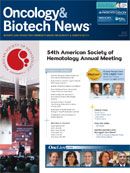Publication
Article
Oncology & Biotech News
ASH Sunday
Author(s):
On Sunday, December 9, 2012, the Plenary Session at the 54th American Society of Hematology Annual Meeting featured several noteworthy abstracts.
Andrew L. Pecora, MD
Editor-in-Chief
Oncology & Biotech News
Chief Innovations Officer, Professor, and Vice President of Cancer Services John Theurer Cancer Center at Hackensack University Medical Center
Each year, hematologists and oncologists pick about a dozen preclinical and clinical trials to present in the plenary format, with the promise of illuminating the path forward to better understanding the diseases we treat, and hopefully giving rise to better therapies. On Sunday, December 9, 2012, the Plenary Session at the 54th American Society of Hematology Annual Meeting featured several noteworthy abstracts.
The first study, presented by Simon J. Stanworth, MRCP, FRCPath, DPhil, John Radcliffe Hospital, United Kingdom, reported the results of the TOPPS trial.1 In the study, Stanworth et al randomized patients with hematological malignancies who had platelet counts <10x109/L to receive a prophylactic platelet transfusion or to be observed. Six hundred patients were randomized and there were more bleeds in the non-prophylaxis group and quicker time to bleeding. The primary endpoint of noninferiority in the non-prophylaxis group was not observed. Thus, for now, while prophylaxis is far from totally protective, it appears better than none.
Hideki Makishima, MD, PhD, Taussig Cancer Institute, and colleagues reported in abstract 2 on their investigation of germ-line mutations of SETBP1, knowing that overexpression in myeloid malignancies of SETBP1 without somatic mutations is associated with a poor prognosis.2 In elegant molecular studies, the authors showed that the leukemic transformation appears fueled by somatic recurrent SETBP1 mutations, indicating that this mutation is a driver of the malignant phenotype in some myeloid malignancies and could some day be a therapeutic target to prevent malignant transformation.
In abstract 3, Kimberly Cramer, PhD, Temple University School of Medicine, and colleagues also explored the malignant phenotype, focusing their attention on RAD52.3 The absence of RAD52, a gene product capable of repair of DNA double-strand breaks that are otherwise lethal to cells, leads to apoptosis and death of leukemia cells. By inhibiting RAD52, the authors observed death among malignant cells without an adverse effect on normal cells. Appropriately, they concluded that blockage of RAD52 activity could result in selective malignant cell death, potentially without toxicity.
Somewhat less complicated, but of equal importance, Tiziano Barbui, MD, Ospedali Riuniti di Bergamo, Italy, and colleagues noted in abstract 4 that it does matter how low one keeps the hematocrit of a patient with polycythemia vera.4 In the CYTO-PV trial, patients’ hematocrits were maintained at <45% or between 45% and 50%. A seemingly innocuous difference turned out to be clinically relevant. The incidence of major thrombosis (the primary endpoint) in the ≥45% hematocrit group was 4.4% compared with 1.1% in the <45% hematocrit group (P = .007). Not surprisingly, there was no difference in the rate of leukemic transformation between groups (the secondary endpoint).
We reentered the world of molecular biology with abstract 5, which was presented by Dan-Avi Landau, MD, Yale Cancer Center.5 Landau et al demonstrated that, while the treating hematologist and his or her patient may feel good as the patient responds to a given therapy, at the cellular level, a “Darwinian” evolutionary-type battle is being played out where the hardiest, malignant subclones grow, mutate, and prosper, as their weaker brethren die off under the environmental adverse pressure of the ongoing therapy. These and other data suggest that in many malignancies, when a patient achieves remission but then relapses, the relapse is a consequence of “Darwinian escape.” Future therapies will seemingly need to block acquired mutations to increase the cure rate.
The final abstract, presented by Francesco Lo-Coco, MD, University Tor Vergata, Italy, reminded us that traditional cytotoxic chemotherapy may one day be a thing of the past.6 His group showed that for patients with non—high-risk acute promyelocytic leukemia, the combination of all-trans-retinoic-acid and arsenic trioxide was not inferior to an anthracycline-containing regimen with regard to 2-year event-free survival.
In summary, I know that the long-awaited discovery of the Higgs boson, the particle that imbues mass to other particles, was the scientific achievement of the year according to Science magazine. However, not dissimilar to our physics brethren, biologists continue to take the wraps off the molecular drivers of cancer, and someday soon, the word cure will be used as frequently as result.
<<<
View coverage from the 2012 ASH Meeting
References
- Stanworth SJ, Estcourt L, Powter G, et al. The effect of a no-prophylactic versus prophylactic platelet transfusion strategy on bleeding in patients with hematological malignancies and severe thrombocytopenia (TOPPS trial). A randomized controlled, non-inferiority trial. Blood. (ASH Annual Meeting Abstracts). 2012;120(21): abstr 1.
- Makishima H, Yoshida K, Nhu Nguyen, et al. Somatic mutations in Schinzel- Giedion syndrome gene SETBP1 determine progression in myeloid malignancies. Blood. (ASH Annual Meeting Abstracts). 2012;120(21): abstr 2.
- Cramer K, Nieborowska-Skorska M, Slupianek A, et al. RAD52-dependent synthetic lethality eradicates leukemia stem cells. Blood. (ASH Annual Meeting Abstracts). 2012;120(21): abstr 3.
- Barbui T, Lunghi M, Tieghi A, et al. A large-scale trial testing the intensity of cytoreductive therapy to prevent cardiovascular events in patients with polycythemia vera (CYTO-PV trial). Blood. (ASH Annual Meeting Abstracts). 2012;120(21): abstr 4.
- Landau D-A, Carter S, Stojanov P, et al. The evolution and impact of subclonal mutations in chronic lymphocytic leukemia. Blood. (ASH Annual Meeting Abstracts). 2012;120(21): abstr 5.
- Lo-Coco F, Avvisati G, Orlando SM, et al. ATRA and arsenic trioxide (ATO) versus ATRA and idarubicin (AIDA) for newly diagnosed, non high-risk acute promyelocytic leukemia (APL): results of the phase III, prospective, randomized, intergroup APL0406 study by the Italian-German Cooperative Groups Gimema-SAL-AMLSG. Blood. (ASH Annual Meeting Abstracts). 2012;120(21): abstr 6.










